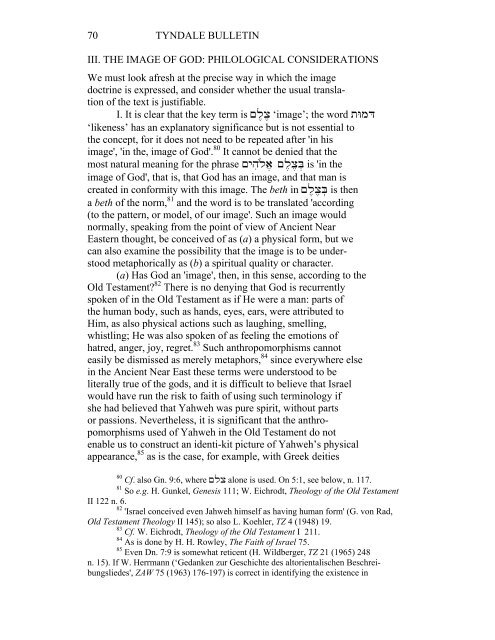THE IMAGE OF GOD IN MAN - Tyndale House
THE IMAGE OF GOD IN MAN - Tyndale House
THE IMAGE OF GOD IN MAN - Tyndale House
- TAGS
- tyndale
- tyndalehouse.com
Create successful ePaper yourself
Turn your PDF publications into a flip-book with our unique Google optimized e-Paper software.
70 TYNDALE BULLET<strong>IN</strong><br />
III. <strong>THE</strong> <strong>IMAGE</strong> <strong>OF</strong> <strong>GOD</strong>: PHILOLOGICAL CONSIDERATIONS<br />
We must look afresh at the precise way in which the image<br />
doctrine is expressed, and consider whether the usual translation<br />
of the text is justifiable.<br />
I. It is clear that the key term is םֶלֶצ ‘image’; the word תּ ומּד<br />
‘likeness’ has an explanatory significance but is not essential to<br />
the concept, for it does not need to be repeated after 'in his<br />
image', 'in the, image of God'. 80 It cannot be denied that the<br />
most natural meaning for the phrase םיִהֹלֶא םֶלֶצְּב<br />
is 'in the<br />
image of God', that is, that God has an image, and that man is<br />
created in conformity with this image. The beth in םֶלֶצְּב<br />
is then<br />
a beth of the norm, 81 and the word is to be translated 'according<br />
(to the pattern, or model, of our image'. Such an image would<br />
normally, speaking from the point of view of Ancient Near<br />
Eastern thought, be conceived of as (a) a physical form, but we<br />
can also examine the possibility that the image is to be understood<br />
metaphorically as (b) a spiritual quality or character.<br />
(a) Has God an 'image', then, in this sense, according to the<br />
Old Testament? 82 There is no denying that God is recurrently<br />
spoken of in the Old Testament as if He were a man: parts of<br />
the human body, such as hands, eyes, ears, were attributed to<br />
Him, as also physical actions such as laughing, smelling,<br />
whistling; He was also spoken of as feeling the emotions of<br />
hatred, anger, joy, regret. 83 Such anthropomorphisms cannot<br />
easily be dismissed as merely metaphors, 84 since everywhere else<br />
in the Ancient Near East these terms were understood to be<br />
literally true of the gods, and it is difficult to believe that Israel<br />
would have run the risk to faith of using such terminology if<br />
she had believed that Yahweh was pure spirit, without parts<br />
or passions. Nevertheless, it is significant that the anthropomorphisms<br />
used of Yahweh in the Old Testament do not<br />
enable us to construct an identi-kit picture of Yahweh’s physical<br />
appearance, 85 as is the case, for example, with Greek deities<br />
80<br />
Cf. also Gn. 9:6, where םלצ alone is used. On 5:1, see below, n. 117.<br />
81<br />
So e.g. H. Gunkel, Genesis 111; W. Eichrodt, Theology of the Old Testament<br />
II 122 n. 6.<br />
82<br />
'Israel conceived even Jahweh himself as having human form' (G. von Rad,<br />
Old Testament Theology II 145); so also L. Koehler, TZ 4 (1948) 19.<br />
83<br />
Cf. W. Eichrodt, Theology of the Old Testament I 211.<br />
84<br />
As is done by H. H. Rowley, The Faith of Israel 75.<br />
85<br />
Even Dn. 7:9 is somewhat reticent (H. Wildberger, TZ 21 (1965) 248<br />
n. 15). If W. Herrmann (‘Gedanken zur Geschichte des altorientalischen Beschreibungsliedes',<br />
ZAW 75 (1963) 176-197) is correct in identifying the existence in

















